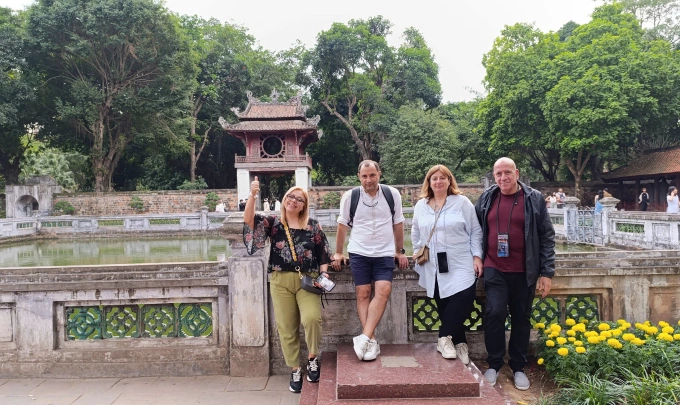Edition: International | Vietnamese
© Copyright 1997 VnExpress.net. All rights reserved.
"When I looked up at the sky, I thought Hanoi looked like London because of the thick fog," the 26-year-old, who arrived in Hanoi with a group of friends on Dec. 10, said.
Only when her tour guide handed out masks and told them about the city’s air quality did she realize what she had seen was fine dust and not fog.
Many foreign visitors shared similar concerns about the air pollution in Hanoi, which has often been ranked among world's worst.
Givanni Gramajomo, 42, a tourist from Guatemala, felt "a little uncomfortable" during his visit to Hanoi in mid-December.
"The thick air and haze made me cough," he said.
Things improved for him when he traveled to Da Nang and other major cities, where it was cooler and breezier, and the skies were much clearer.
American tourist Lily Guthrie said during her three-day stay in Hanoi, she experienced eye irritation and fatigue despite avoiding excessive screen time.
 |
|
A group of American tourists pose for photos at the Temple of Literature in Hanoi under unclear sky on Dec. 22, 2024. Photo courtesy of Du Lich Viet |
"I think it was due to the polluted air," she said.
Hanoi's air quality has worsened since October, coinciding with the seasonal transition to winter, according to the Department of Natural Resources and Environment.
On Dec. 23 two out of three monitoring stations in the city recorded "very poor" air quality, with the Air Quality Index (AQI) exceeding 200, a level considered harmful to health.
Between 9 p.m. and 11 p.m. on Dec. 21, the AQI soared to 380, classified as "hazardous" and requiring urgent health precautions.
On Dec. 10 data from over 30,000 global air quality monitoring stations ranked Hanoi as the most polluted city in the world, with an overall AQI of 198.
 |
|
A woman living in Hanoi rides her motorbike in poor air quality conditions, December 2024. Photo by VnExpress/Ngoc Thanh |
Despite the poor air quality, James said she "really liked" the Vietnamese capital for its rich culture, delicious cuisine and friendly people.
Both Gramajomo and Guthrie echoed her sentiments.
Gramajomo expressed optimism, saying Hanoi's air quality was "not always bad" and "there were some very happy days there."
Travel companies in Hanoi reported that the old quarter, Hoan Kiem Lake, Ngoc Son Temple, Ho Chi Minh Mausoleum, One Pillar Pagoda, Temple of Literature, Bat Trang pottery village, and the Museum of Ethnology remain popular attractions for international tourists.
On days with particularly poor air quality, tour guides often adjust itineraries to destinations with cleaner air such as Ninh Binh and Ha Giang.
Concerns for tourism industry
Pham Anh Vu, deputy general director of travel firm Du Lich Viet, which specializes in inbound tourism, said Hanoi’s air pollution is a serious issue for the tourism sector.
He warned of potential long-term consequences if visitors' health and experiences continue to be affected.
"If the air quality remains poor, tourism stimulus policies such as relaxed visa regulations may become less effective."
Tourists from developed countries with high environmental standards, such as Japan, New Zealand and northern European nations, are particularly sensitive to pollution, he said.
Visible pollution and unhealthy air could deter them from visiting Hanoi, especially during peak international tourist seasons like December, harming the city's reputation as a safe and welcoming destination and reducing Vietnam's tourism competitiveness, he said.
Nguyen Tien Dat, vice president of the Hanoi Tourism Association, also warned that tourists from less polluted countries like New Zealand might "never return" if their experiences in Hanoi are tarnished by air pollution.
Hanoi has identified five main sources of air pollution: road traffic (including dust), industrial emissions, residential activities, biomass burning, and agriculture.
Both the Ministry of Natural Resources and Environment and city authorities are admittedly implementing measures to reduce emissions.
For example, Hanoi is developing low-emission zones to combat traffic pollution and bolstering street cleaning efforts to mitigate construction dust.
James said: "My friend told me that Hanoi’s sky is usually beautiful—clear and blue. I hope next time I visit I’ll see that blue sky instead of this hazy white."